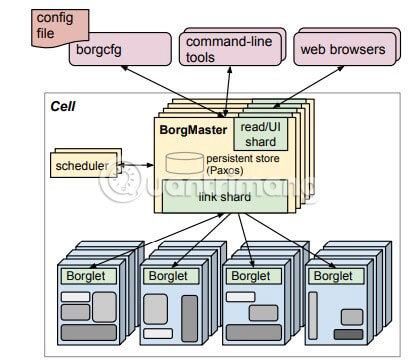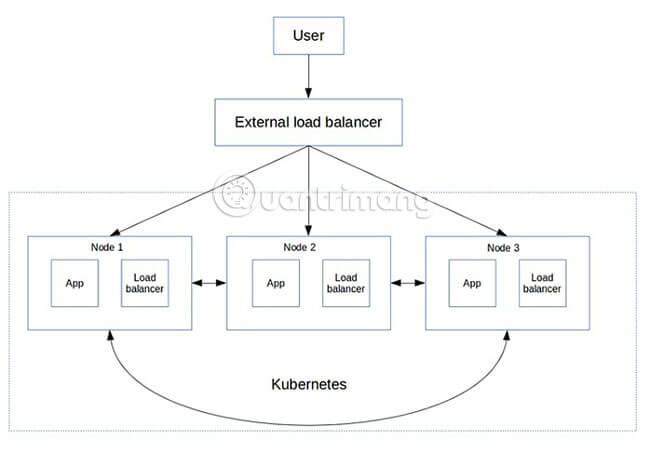What is Kubernetes?
Kubernetes (pronounced CUBE-A-NET-IS) is an open source platform that helps manage container applications like Docker. Whether you are trying to automate or expand these containers on multiple servers, Kubernetes can help speed up deployment. To speed up deployment, Kubernetes uses internal components such as Kubernetes API or third-party extensions that run on Kubernetes.
This article will help you understand the basic concepts of Kubernetes and why it causes such 'shocks' in the server market. From server service providers to cloud providers, like Azure and Google Cloud, all have Kubernetes.
Brief history of Kubernetes
Kubernetes is one of the gifts that Google offers to the open source community. Container platform is part of Borg, Google's internal project for more than a decade. Borg allows Google to manage hundreds and even thousands of tasks (called 'Borglet') from many different applications on clusters. Its goal is to effectively use physical machines (and virtual machines) while ensuring the high availability of run-time features.

In 2015, as soon as Kubernetes 1.0 appeared, Google gave up control of the technology. Kubernetes currently has a platform called Cloud Native Computing Foundation (CNCF). It is itself part of the Linux Foundation.

How Kubernetes works
Borrowing the idea of Project Borg, Borg gave way to the pod, which contained containers.

Pod ensures high availability by balancing the traffic load in round-robin format. Furthermore, pods inside machines (or virtual machines) are called 'workers nodes' or 'minions'. From this point on, the 'master node' will control through the coordination of containerization using the Kubernetes API. Docker is capable of running in every worker node, where it can download images and start containers.

To get API connection at the Kubernetes cluster, the CLI syntax (also called kubectl) is used. This is a very important command because it runs all commands that the master node serves for node workers. To master kubectl, you have to spend some time learning, but then you can start using Kubernetes clusters. Kubernetes as well as Docker are written in the Go programming language.
These applications
Kubernetes can significantly reduce server and data center costs thanks to high efficiency. Some popular Kubernetes applications include:
- Application server management: Most application servers require security, configuration management, updates and more, can run with Kubernetes.
- Deploy stateless applications (without saving client data on the server): Web applications can now be remote controlled. For example, Kubernetes can help run Nginx servers by using stateless application deployment methods.
- Deploy stateful applications (save client data on the server): Kubernetes can run MySQL databases.
- Store API objects . For different storage needs, Kubernetes ensures ideal storage because it uses container rules.
- Kubernetes is useful in innovative applications such as service discovery, logging, monitoring and authentication.
- IoT: Kubernetes application is being used more and more in IoT thanks to its scalability.
- Run anywhere: You can run Kubernetes anywhere, including inside a suitcase.

Kubernetes' goal is to use computing resources to the fullest extent. Because you can arrange containers on multiple servers, the end nodes will never experience resource problems or errors. Kubernetes helps scale automatically because you only have to issue a command once from the master node.
You should read it
- How to Delete Your Usage History Tracks in Windows
- 3 Extensions that support managing browsing history in Chrome
- How to delete browsing history on Coc Coc?
- Search for deleted browser history with History Search
- How to delete browsing history on iOS9
- How to export Chrome browsing history to HTML, CSV or TXT file
- How to delete Netflix history
- How to delete transaction history on Google Pay
May be interested
- How to use GoChat application in Pokémon GO
 pokémon go has become a very hot phenomenon since its debut. any information or tricks related to the game are read and applied by players during the process of catching pokémon. and the gochat chat app for pokémon go players brings space to capture pokémon much more interesting.
pokémon go has become a very hot phenomenon since its debut. any information or tricks related to the game are read and applied by players during the process of catching pokémon. and the gochat chat app for pokémon go players brings space to capture pokémon much more interesting. - How to play Pokemon GO in Landscape Mode on the iPhone
 although players can play pokemon go in portrait mode. however, if you want to watch and play games on a large and eye-catching screen, players can switch to playing games in landscape mode.
although players can play pokemon go in portrait mode. however, if you want to watch and play games on a large and eye-catching screen, players can switch to playing games in landscape mode. - The secret to controlling Pokemon Go employees at work
 these days, hr managers are faced with an extremely painful problem that is the status of priority employees playing pokemon go more than work. this has caused a small impact on productivity and efficiency.
these days, hr managers are faced with an extremely painful problem that is the status of priority employees playing pokemon go more than work. this has caused a small impact on productivity and efficiency. - Check out the 'buffalo' Pokémon in Pokémon Go
 each type of pokemon has hp, cp, ability to attack and endure differently. based on these indicators, players can determine as well as choosing the most powerful pokemon for their offensive tactics.
each type of pokemon has hp, cp, ability to attack and endure differently. based on these indicators, players can determine as well as choosing the most powerful pokemon for their offensive tactics. - Sitting home can also locate Pokemon around, do you believe it?
 the tightening of the niantic developers' rules to prevent players from abusing the support tools also brings annoyance, such as those who have no conditions to move much, go away, it is hard to know. get the location of the pokemon around the area they live in
the tightening of the niantic developers' rules to prevent players from abusing the support tools also brings annoyance, such as those who have no conditions to move much, go away, it is hard to know. get the location of the pokemon around the area they live in - 5 undeniable benefits when playing Pokemon Go
 get to know many new people, breathe fresh air, relieve stress, increase concentration thanks to going out for a walk .... are compelling reasons to force you to try pokemon go now .
get to know many new people, breathe fresh air, relieve stress, increase concentration thanks to going out for a walk .... are compelling reasons to force you to try pokemon go now . - Want to earn the fastest Pokécoins in Pokémon Go? So don't miss this article!
 pokécoins in pokémon go play the role of buying items in the store. the more coins you earn, the more likely you are to buy more items. to earn pokécoins, players will have to complete certain tasks or buy real money.
pokécoins in pokémon go play the role of buying items in the store. the more coins you earn, the more likely you are to buy more items. to earn pokécoins, players will have to complete certain tasks or buy real money. - Pokémon systems when fighting in Pokémon Go
 each pokémon system in pokémon go has different strengths, along with a specific weakness. this type of pokémon will have the power to attack the other pokémon, but can defeat the other pokémon. if you know the characteristics of each type, it will be easier to choose which pokémon to battle.
each pokémon system in pokémon go has different strengths, along with a specific weakness. this type of pokémon will have the power to attack the other pokémon, but can defeat the other pokémon. if you know the characteristics of each type, it will be easier to choose which pokémon to battle. - The terms you need to know when playing Pokémon Go
 pokémon go is the most prominent name in recent days. this game of capturing and training virtual animals has created a relatively new way of playing, as players have to constantly move to catch pokémon. during the process of joining pokémon go, you will encounter and use a lot of important terms. so what do they mean?
pokémon go is the most prominent name in recent days. this game of capturing and training virtual animals has created a relatively new way of playing, as players have to constantly move to catch pokémon. during the process of joining pokémon go, you will encounter and use a lot of important terms. so what do they mean? - How to play Pokemon GO on Windows computers
 recently, pokemon go has become a popular game, attracting thousands of gamers around the world. in previous posts network administrator has guided you on how to play pokemon go on android devices and ios devices. in the article below, network administrator will guide you how to play pokemon go on windows computers using bluestacks emulator software.
recently, pokemon go has become a popular game, attracting thousands of gamers around the world. in previous posts network administrator has guided you on how to play pokemon go on android devices and ios devices. in the article below, network administrator will guide you how to play pokemon go on windows computers using bluestacks emulator software.










 Learn about stalkerware
Learn about stalkerware Learn about Telnet protocol
Learn about Telnet protocol Learn about blue light filters
Learn about blue light filters Understanding Network Operating System Network Operating System (NOS)
Understanding Network Operating System Network Operating System (NOS) What is webinar?
What is webinar? Learn about KaiOS - the third most popular mobile operating system
Learn about KaiOS - the third most popular mobile operating system